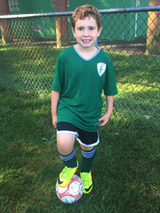Arterial Ischemic Stroke: Jacob’s Story
Arterial Ischemic Stroke: Jacob’s Story
Seven-year-old Jacob is as active as they come. He plays basketball, soccer, baseball and tennis, and enjoys swimming at the beach. It’s hard to believe, watching him now, that five years ago his parents were told he might never walk normally again.

When Jacob was 2, he was playing with his older sister, Isabel, when he suddenly fell to the ground and the left side of his body went limp.
His parents, Jill and Jordan, took him to the emergency room at Robert Wood Johnson University Hospital in New Brunswick, NJ. Doctors there determined that he had suffered a stroke. In explaining this to Jill and Jordan, they warned that the damage might be permanent and that he might never walk normally again.
Jacob was in the hospital for a week, then in a rehabilitation facility for another two weeks. An MRI scan was done to see if there were any blockages or anatomical issues that might put Jacob at risk for another stroke. Thankfully, there weren’t — the incident appeared to be an isolated event. Most of the muscle control on his left side was gone, but with therapy he could manage some movement of his left arm and leg.
Seeking out pediatric stroke experts
Over the course of those first few weeks, Jacob’s family started researching strokes in children. That research led them to the Pediatric Stroke Program at Children’s Hospital of Philadelphia (CHOP), which brings together all of the specialists involved in the care of children who’ve suffered a stroke. They read about the team that works together to minimize damage from a child’s stroke and prevent future strokes, and were impressed by the experience of program director Rebecca Ichord, MD. They made an appointment at CHOP as soon as Jacob was released from rehab.
“When we met Dr. Ichord, we knew we’d found the right person,” Jill recalls. “This was normal for her. She’d seen lots of children with stroke, and she told us that with therapy we could get Jacob back to where he was.”
Dr. Ichord credits the medical team at Robert Wood Johnson with getting Jacob off to a good start with his recovery. She and the rest of the multidisciplinary stroke team picked up his care from there, coordinating ongoing therapy to rebuild his strength and mobility, and seeing him for regular follow-up visits.
Back on his feet

That was five years ago, and Jacob has made tremendous progress in that time.
Under Dr. Ichord’s guidance, he has worked with local physical and occupational therapists near his home in New Jersey. He had to learn how to crawl again, then how to cruise holding onto furniture, then how to walk. It was a year before he was able to walk up the stairs again.
“At this point you could never tell by watching him that he’d ever had a stroke,” says Jill. He has the coordination and speed to play several different sports, and loves being physically active.
“As his mother, I can see small signs when he’s tired,” she says. “He’ll get a little clumsy, his smile will be a bit lopsided. But if you didn’t know to look, you’d never notice.”
Throughout it all, Jill and Jordan appreciated how calm, confident and accessible Dr. Ichord and the stroke team at CHOP have been.
“That first year I was a nervous wreck,” Jill recalls. “I needed to know what was safe for him. Any question I had, I could send it to Dr. Ichord and she got right back to me. She has been wonderful through this whole long process.”
Now Jacob’s future looks just as bright as it did before his stroke.
Originally published December 2016